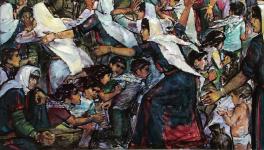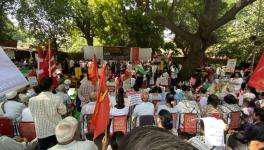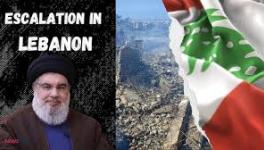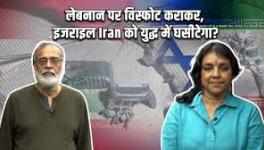How US, Israel Birthed the Suicide Car Bomber
The 100-year history of the car bomb played out in a miniaturised version in the week before the departure of the United States of America from Afghanistan. A suicide bomber attacked Kabul airport, killing over 170 civilians and 13 marines. The Americans retaliated and claimed to have liquidated the mastermind of the Kabul airport explosion. This apparent success was marred by the death of a family of ten, including six children, in an American drone attack on a vehicle in Kabul. The Americans thought the vehicle was loaded with explosives.
The tit-for-tat in Kabul shows nations, particularly those technologically advanced, have the capacity to deliver bombs over long distances or from great heights without having to come close to their targets. By contrast, insurgents have to creep in proximity to their foes to bomb or kill them. At the root of suicide car bombing is the asymmetrical nature of the conflict between the might of the nation-state and insurgent groups lacking in firepower and technological prowess.
Decades ago, suicide bombing was not the favoured method of the weak to challenge the powerful. In his fascinating work, ‘Buda’s Wagon: A Brief History of the Car Bomb’, historian and political activist Mike Davis narrates the story of Mario Buda, an alienated Italian who was a follower of anarchist theorists Luigi Galleani. Angry at America’s deportation of Galleani, Buda parked a horse-drawn carriage, loaded with explosives, at the corner of Wall Street and Broad Street, opposite JP Morgan and Company, in Manhattan in 1920. The carriage blew up, killing 40 people and injuring another 200.
Carriage of Death
Davis’s description of the carnage makes out the Wall Street explosion as a forerunner of the apocalyptic scenes following the 2001 attack on New York’s World Trade Center. He writes, “Windows exploded in the faces of office workers, pedestrians were mowed down by metal shrapnel or scythed by shards of glass… Skyscrapers quickly emptied. Panicked crowds fled past crumpled bodies on the side-walks, some of them writhing in agony.”
Apart from the scale of violence, the 1920 Wall Street explosion differed from 9/11 on one count: In contrast to Buda slipping out of the US to Italy, all the 9/11 assailants perished. Between these two events, the carriage bomb evolved into a car bomb and, then, into vehicles of suicide bombers.
These vehicles of death have, in contemporary memory, become a defining aspect of Muslim radicals. Although Sri Lanka’s Tamil Tigers were as adept as any in using car bombs, their drivers often dying. However, they did not attract global attention because their victims were neither Americans nor Israelis.
Herein is the irony: The US and Israel did not hesitate to deploy the car bomb to achieve their missions.
Israel’s innovation
In fact, according to Davis, the Israelis were the first to weaponise the car successfully. Between 1947 and 1949, which the Israelis remember as the War of Independence and the Palestinians as Nakba or Catastrophe, cars or trucks became favoured weapons of Zionist guerrillas.
On 12 January 1947, the Stern gang, named after its founder Avram Stern, who had broken broke away from Irgun, or the National Military Organisation in the Land of Israel, drove a truckload of explosives into a British police station in Haifa, Palestine, killing four and injuring 140.
The Stern gang was soon joined by Irgun militants. Together, they initiated a wave of attacks on the British, which had the mandate to govern Palestine Territory, and Palestinians. J. Bowyer Bell writes, in ‘Terror out of Zion – Irgun Zvai Leumi, LEHI and the Palestinian Underground’: “The Jews were the first to use explosives for the purpose of killing Arabs indiscriminately… But it wasn’t long before the Arabs struck back using the enemy’s own weapons.”
Among the Irgun militants was Menachem Begin, who was to become Israel’s sixth prime minister later. Begin wrote of his Irgun days in his memoir ‘Revolt’. Decades later, journalist Lawrence Wright found militants in the Al Qaeda camp in Afghanistan reading ‘Revolt’, which they considered a classic handbook of successful terrorism.
History, indeed, recoils in ironic ways. The car bomb was here to stay.
Saigon, IRA and Algeria
Pitted against America’s relentless bombing spree of Vietnam, the Viet Cong, officially known as the National Liberation Front of South Vietnam, used cycles, cars and trucks to kill Americans until they evacuated from Saigon. The Irish Republican Army deployed the car bomb to hurt the British, which, it was revealed years later, also used the same method to scar Belfast.
The National Liberation Front (FLN) in Algeria resorted to car bombs in its struggle for independence from France. They then took the battle into France. Davis writes, “Fuel dumps were blown up, gendarmes were machine gunned… but there were no car bombs or public massacres on the mainland.”
Such restraint was not shown by the Organisation de l’Armée Secrète (OAS), which sought to retain the supremacy of French settlers in Algeria. The OAS took to targeting the French security forces, peace activists, and Algerian civilians through, yes, the car bomb.
According to British journalist and historian Alistair Home, the CIA assisted the OAS, hoping a country carved out by pieds-noirs (those who had French or European origin but were born in Algeria), would enable the US to establish military bases and improve its access to the country’s oil. Algeria, a Muslim country, became independent in 1962.
The car bomb constituted the arsenal not only of national movements but also of the Italian mafia. They rigged cars with bombs to knock out their rivals.
The most devastating turn in the history of the car bomb came in Beirut, Lebanon, where the suicide car bomber emerged.
Beirut’s car bombs
In the late 1970s, Beirut had become the battlefield of warring ideologies and militias representing Sunni and Shia Muslims, Druzes (followers of an Abrahamic religion taught by Hamza ibn Ali ibn Ahmad), and Maronite Christians. It was also here the Palestinian refugees expelled from Israel resided. Beirut was the playground where Syria, Iraq, Iran, Israel, the US and France contested. The Mossad, Israel’s intelligence agency, used the car bomb in Beirut as early as July 1972 to kill famous novelist Ghassan Kanafani, who was also the spokesperson for the Popular Front for the Liberation of Palestine. Retribution followed.
But these incidents were sporadic and, according to Davis, a prelude to the sustained terrorising of Muslims in West Beirut from late summer 1981 through early 1983. He writes, “A succession of car bombings that were evidently part of the joint Israeli-Phalangist (the latter represented Christians) campaign to evict the Palestinian Liberation Organisation [PLO] from Lebanon. For 18 months, a hellish chess game was played out with TNT-packed taxis and trucks in a vain attempt to intimidate the popular anti-Israeli forces in the Levant. In 1981 alone, more than 200 civilians were killed in 18 car bomb explosions in the Lebanese capital.”
In 1982, the Israelis invaded Lebanon. The Israeli Air Force dropped cluster bombs, and cars were rigged to devastate Muslim neighbourhoods and refugee camps. Davis quotes Palestinian scholar Rashid Khalidi saying that “a sequence of public confessions by captured drivers made clear these [car-bombings] were being utilised by the Israelis and their Phalangist allies to increase the pressure on the PLO to leave.” It was also the period during which the massacre at Sabra and Shatila refugee camps took place. (Syria jumped into Beirut’s bloody cauldron as a series of bombings rocked Damascus. That is, though, another story.)
The suicide car bomber rises
Beirut’s bloody backdrop is said to have birthed the first suicide car bomber—Dair Qanoun al-Nahr—or so the Shia militia group Hezbollah claims. He drove a bomb-laden car into Israel’s seven-story headquarters in Tyre, Lebanon, killing 141. Another Shia bomber attacked the same building and killed 60, including top officials of Shin Bet, yet another Israeli intelligence agency.
Thereafter, the Hezbollah turned its deathly gaze upon the US and France troops, who largely comprised the Multinational Force (MNF), formed to evacuate the PLO from Beirut safely. But the MNF took to openly supporting the Christian Maronite government against the Muslim-Druze majority. Grenade, rocket and sniper attacks on the US Embassy in Beirut did not dissuade American President Ronald Reagan to change tack.
On 18 April 1983, a pickup truck barged through the American Embassy’s lobby, detonating 2000 pounds of ANFO (ammonium nitrate/fuel oil) explosives. About the attack, journalist Robert Fisk wrote, “The centre of the Embassy was missing. The bottom of the two wings of the Embassy had disappeared.” Months later, the US destroyers bombed the positions of the Druze militia, and in October, the Lebanese Army demolished a Shiite slum. Weeks later, the driver of a Mercedes dumper, packed with 12000 pounds of high explosives, attacked the US military barracks, killing nearly 299 marines.
It was evident that the suicide car bomber was a species apart.
CIA’s senseless revenge
William Casey, the CIA’s director then, was thirsting for revenge. With the Saudis, he planned to liquidate Sheikh Mohammad Hussein Fadlallah, alleged to have plotted the killing of US marines. According to celebrated journalist Bob Woodward, the killing was contracted to a former British SAS officer. A Datsun pickup truck was parked near Fadlallah’s house. The truck exploded: it killed around 40 people and maimed many. But Fadlallah was not even injured.
The “Fadlallah fiasco” had Casey turn his attention to Afghanistan, where the Soviets were already present. In ‘Ghost Wars: The Secret History of the CIA, Afghanistan and bin Laden’, journalist Stephen Coll says Casey thought “political Islam and Catholic Church” were natural allies in the crusade to vanquish the communist Soviet Union.
Davis writes that Casey created a “compartmentalised chain of command” to conceal his own role. At the top of the chain were Casey and Prince Turki bin Faisal al Saud, the head of the Saudi intelligence agency. Below them were President Ziaul Haq and Brigadier Mohammad Yousaf, head of Pakistan’s Inter-Services Intelligence (ISI). US Special Forces taught state-of-the art sabotage techniques, including rigging car bombs, to ISI officials in scores of training camps, which Saudi Arabia and the Gulf Emirates financed. These ISI officials passed the know-how to thousands of Afghans and foreign jihadis, including those who later became Al Qaeda members.
The ISI was in control of who were to be recruited and receive arms and funds. They favoured radical Islamic groups. Coll writes, “By the late 1980s, the ISI had effectively eliminated all the secular, Leftist, and royalist political parties.” Among the training camps was the “University of Dawa and Jihad”, located outside Peshawar. With their sabotage skills honed in the University, its alumni ravaged Kabul for four long years, intensifying their attacks as the Soviet Army began preparations in 1988 to withdraw from Afghanistan.
Casey was jubilant, for America’s bloody nose in Beirut had been avenged. But American’s Afghanistan policy was myopic, for, as Coll writes, “It was the greatest transfer of terrorist technology in history: there was no need for angry Islamists to take car-bomb extension courses from Hezbollah when they could matriculate in a CIA-supported urban-sabotage course in Pakistan’s frontier forces.”
The Blowback
Riding high on their successes in Afghanistan, the CIA had Iyad Allawi, the Iraqi leader who ran an organisation from exile, to detonate car bombs and spread mayhem in Baghdad. The CIA hoped it could bring down Iraqi President Saddam Hussein. The New York Times, in a 2004 report, cited Robert Baer, a former CIA officer, to say the saboteurs even blew up a school bus.
Yet, at the same time, the alumni of militant camps in Afghanistan were thinking of deploying the sabotage tactics against the US, their veritable tutor, for its support for Israel and bolstering Arab dictators. The first sign of this came when Ramzi Yousef, trained in Peshawar’s University, attacked the World Trade Centre in 1993. He underestimated the amount of explosions needed to substantially damage the WTC. Eight years later, his uncle, Khalid Sheikh Mohammed, masterminded the 9/11 attack, which had planes smashing into the WTC towers.
The blowback from Afghanistan continued even after the Americans invaded and occupied Iraq. Their administration and the Army encountered a torrent of car bombs. The deadlier of them were executed by Abu Musab al-Zarqawi, yet another alumnus of a CIA-run camp in Afghanistan.
With the Americans departing from Afghanistan 100 years after Wall Street was ripped apart, the last sentence of Mike Davis’s book is telling: “Buda’s wagon truly has become the hot rod of the apocalypse.” It can only be hoped that it ceases to be so.
The author is an independent journalist. The views expressed are personal.
Get the latest reports & analysis with people's perspective on Protests, movements & deep analytical videos, discussions of the current affairs in your Telegram app. Subscribe to NewsClick's Telegram channel & get Real-Time updates on stories, as they get published on our website.
























